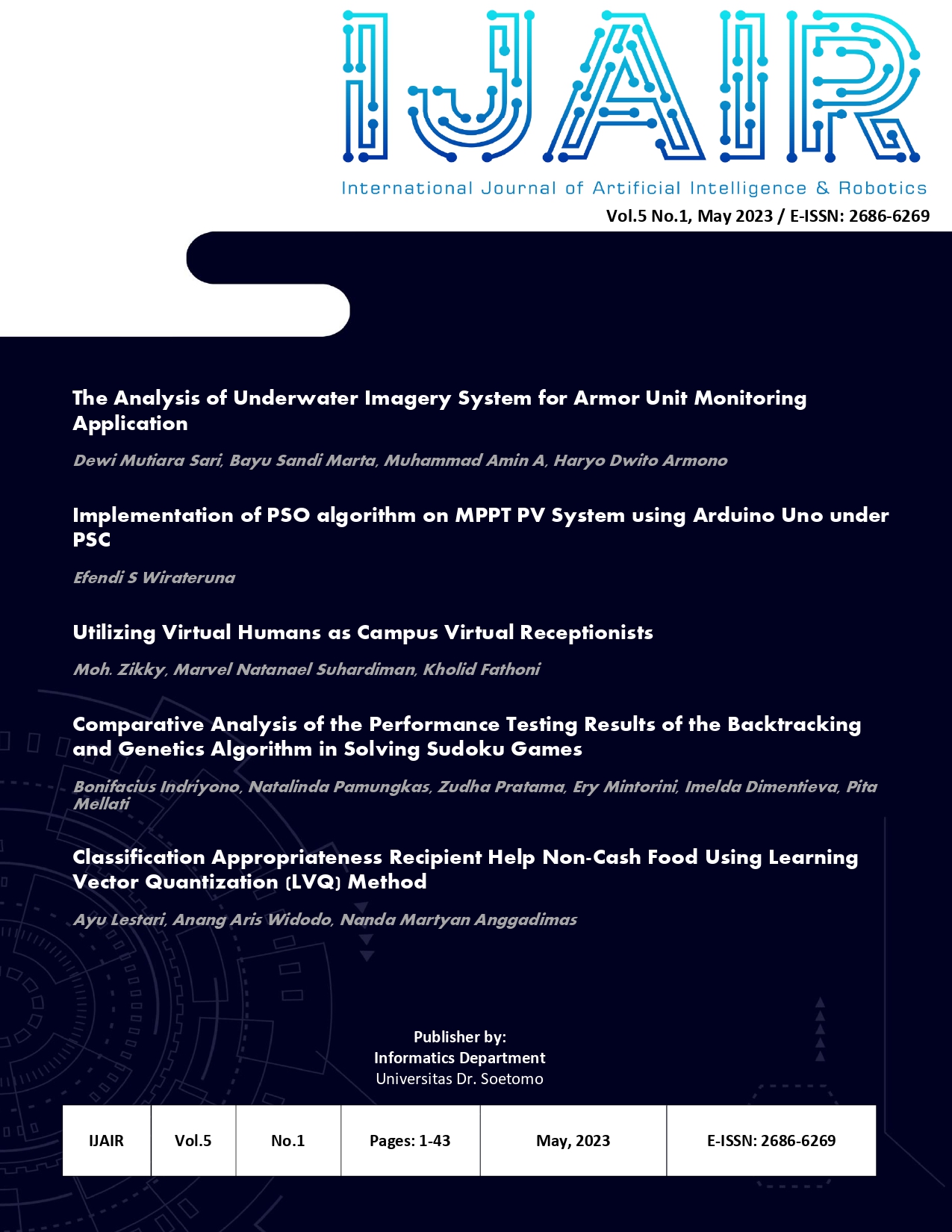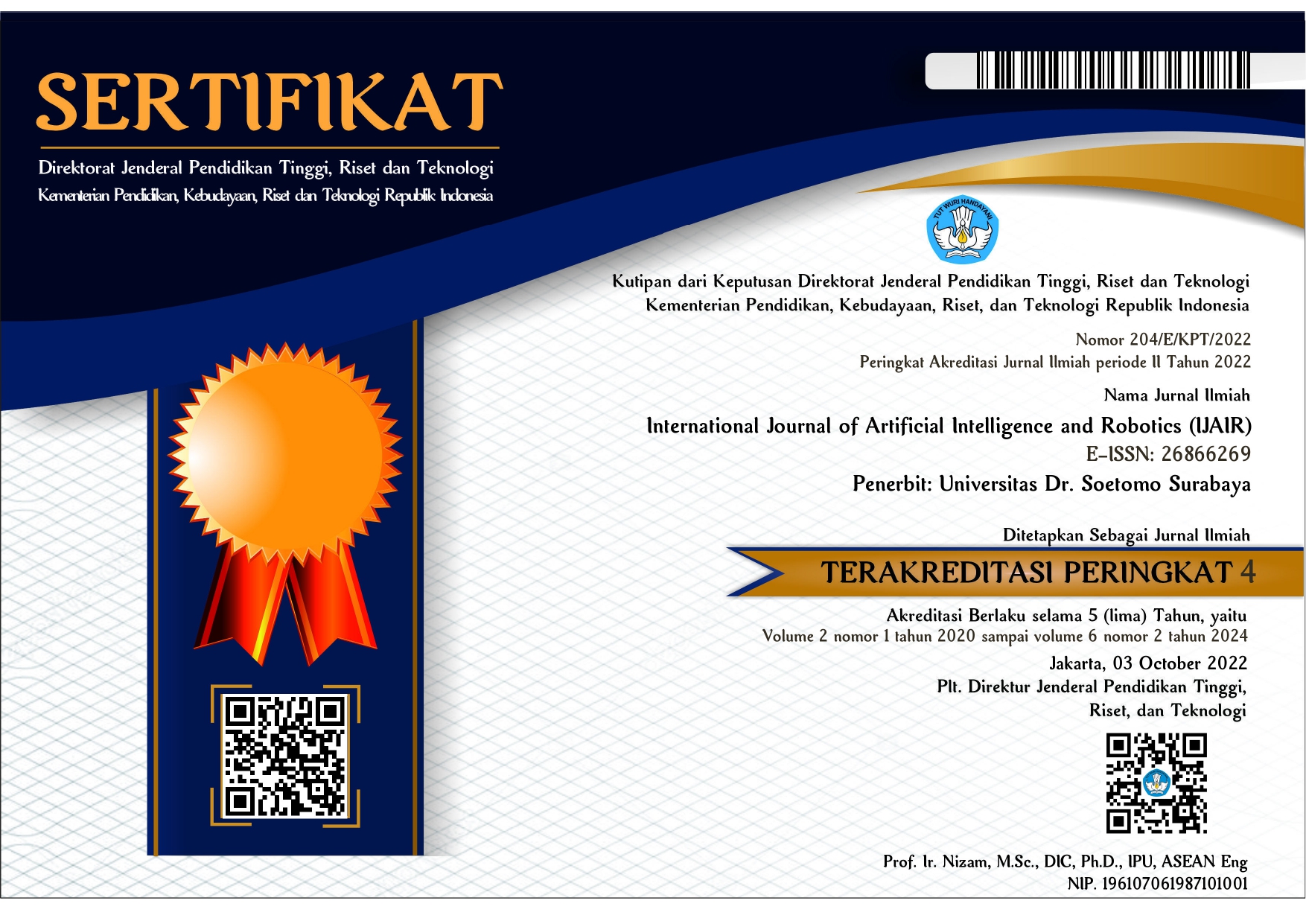Classification Appropriateness Recipient Help Non-Cash Food Using Learning Vector Quantization (LVQ) Method
 Abstract views: 268
,
Abstract views: 268
,
 PDF downloads: 222
PDF downloads: 222
Abstract
Help Non-Cash Food is a program from the Government that is used to overcome poverty. The program is not functioning as well as it could because the procedure of receiving aid is not uniform, and individuals responsible for making choices are having trouble determining which families are qualified to receive the assistance. To overcome this problem, a classification system is needed to classify the eligibility of Non-Cash Food Assistance recipients so that the results are more efficient and accurate. This research uses the Learning Vector Quantization (LVQ) method with Python. This research aims to implement the LVQ method for the eligibility classification of non-cash food assistance recipients. System design is a stage that contains the process from start to finish of running this system which is described in the form of a flowchart, including system requirements that support this research, both software and hardware. In the process of analyzing the results and tests that are used as evaluation material in the process of finding a solution to a problem and making decisions in the process of planning activities, it is necessary to assess whether or not the LVQ approach is practicable to apply based on the findings of the research. In this study, 200 datasets were used with three epoch values and a learning rate of 0.1. The data set was randomly divided into a training portion of 80% and a testing portion of 20%. So that the results of this research using the LVQ method on the eligibility classification of recipients of Non-Cash Food Assistance obtain an accuracy of 97.5%.
Downloads
References
M. Ahmad Yanda, "Penentuan Penerima Bantuan Pangan Non Tunai (BPNT) Menerapkan Metode Multi Objective Optimization on the Basis of Ratio Analysis (MOORA)," Bulletin of Informatics and Data Science, vol. 1 No 2, pp. 38-45, 2022.
D. A. N. F. Khotim Fadhli, "Pengaruh Pendapatan, Pendidikan, dan Gaya Hidup Terhadap Kesejahteraan Keluarga Penerima Manfaat (KPM) Bantuan Sosial Covid-19," Journal Education and Development, vol. 9 No 3, pp. 118-124, 2021.
E. Ermawati, "Algoritma Klasifikasi C4.5 Berbasis Particle Swarm Optimization untuk Prediksi Penerima Bantuan Pangan Non Tunai," SISTEMASI : Jurnal Sistem Informasi, vol. 8 No 3, pp. 513-528, 2019.
Peraturan Presiden Republik Indonesia Nomor 63 Tahun 2017, Penyaluran Bantuan Sosial Non Tunai, 2022.
Badan Pusat Statistik, Kemiskinan dan Ketimpangan Pendapatan, 2021.
Badan Pusat Statistik, Penerima Bantuan Pangan Non Tunai (BPNT)/Program Sembako, Sistem Informasi Statistik, 2022.
O. Nurdiawan, "Seleksi Penerima Bantuan Sosial Berdasarkan Sistem Pendukung Keputusan Dalam Upaya Mengurangi Siswa Rawan Putus Sekolah," Jurnal Teknologi Informasi, vol. 8 No 2, pp. 32-40, 2018.
I. H. K. A. S. E. M. A. A. P. J. Aryo De Wibowo Muhammad Sidik, "Gambaran Umum Metode Klasifikasi Data Mining," FIDELITY : Jurnal Teknik Elektro, vol. 2 No 2, pp. 34-38, 2020.
S. Wang Hoaxiang, "Big Data Analysis and Pertubation using Data Mining Algorithm," Journal of Soft Computing Paradigm (JSCP), vol. 3 No 1, pp. 19-28, 2021.
M. H. W. E. P. F. F. W. W. G. Riyan Latifahul Hasanah, "Klasifikasi Penerima Dana Bantuan Desa Menggunakan Metode KNN (K-Nearest Neighbor)," Jurnal TECHNO Nusa Mandiri, vol. 16 No 1, pp. 1-6, 2019.
M. T. F. C. D. Romlah Tantianti, "Implementasi Metode Learning Vector Quantization (LVQ) untuk Klasifikasi Persalinan," Jurnal Pengembangan Teknologi Informasi dan Ilmu Komputer, vol. 3 No 10, pp. 9701-9707, 2019.
E. S. B. R. Ivan Agustinus, "Klasifikasi Risiko Hipertensi Menggunakan Learning Vector Quantization (LVQ)," Jurnal Pengembangan Teknologi Informasi dan Ilmu Komputer, vol. 2 No 8, pp. 2947-2955, 2018.
R. R. H. I. Muhammad Rianto, "Penerapan Data Mining Dengan Metode Naive Bayes Dan Learning Vector Quantization Credit Rating Dalam Memprediksi Kelayakan Pemberian Kredit Oleh PT. BPR Lebak Sejahtera," Jurnal Teknologi Informasi, vol. 17 No 1, pp. 69-76, 2022.
O. N. Washilaturrizqi, "Implementasi Algoritma C4.5 Untuk Menentukan Penerima Bantuan Sosial (Studi Kasus: Klasifikasi Kemiskinan Desa Lurah)," JATI (Jurnal Mahasiswa Teknik Informatika), vol. 7 No 1, pp. 373-377, 2023.
Kementrian Sosial, Pedoman Bantuan Pangan Non Tunai, 2019.
"Implementasi Program Bantuan Pangan Non Tunai (BPNT) Di Kecamatan Sitinjau Laut Kabupaten Kerinci," Qawwam : The Leader's Writing, vol. 1 No 1, pp. 38-43, 2020.
H. F. Nugrahana Fitria Ruhyana, "Strategi Kebijakan Pemerintah Kabupaten Sumedang Dalam Penyaluran Bantuan Sosial Di Masa Pandemi Covid-19," Khazanah Intelektual, vol. 4 No 2, pp. 789-804, 2020.
U. R. H. R. M. A. Amat Damuri, "Implementasi Data Mining dengan Algoritma Naive Bayes Untuk Klasifikasi Kelayakan Penerima Bantuan Sembako," JURIKOM (Jurnal Riset Komputer), vol. 8 No 2, pp. 219-225, 2021.
E. S. B. R. Ivan Agustinus, "Klasifikasi Risiko Hipertensi Menggunakan Metode Learning Vector Quantization (LVQ)," Jurnal Pengembangan Teknologi Informasi dan Ilmu Komputer, vol. 2 No 8, pp. 2947-2955, 2018.
A. B. Mercury Fluorida Fibrianda, "Analisis Perbandingan Akurasi Deteksi Serangan Pada Jaringan Komputer Dengan Metode Naive Bayes Dan Support Vector Machine (SVM)," Jurnal Pengembangan Teknologi Informasi dan Ilmu Komputer, vol. 2 No 9, pp. 3112-3123, 2018.
Copyright (c) 2023 Ayu Lestari Tari, Anang Aris Widodo, Nanda Martyan Anggadimas

This work is licensed under a Creative Commons Attribution-ShareAlike 4.0 International License.
Authors who publish with International Journal of Artificial Intelligence & Robotics (IJAIR) agree to the following terms:
-
Authors retain copyright and grant the journal right of first publication with the work simultaneously licensed under a Creative Commons Attribution License (CC BY-SA 4.0) that allows others to share the work with an acknowledgment of the work's authorship and initial publication in this journal.
-
Authors are able to enter into separate, additional contractual arrangements for the non-exclusive distribution of the journal's published version of the work (e.g., post it to an institutional repository or publish it in a book), with an acknowledgment of its initial publication in this journal.
-
Authors are permitted and encouraged to post their work online (e.g., in institutional repositories or on their website) prior to and during the submission process, as it can lead to productive exchanges, as well as earlier and greater citation of published work.















